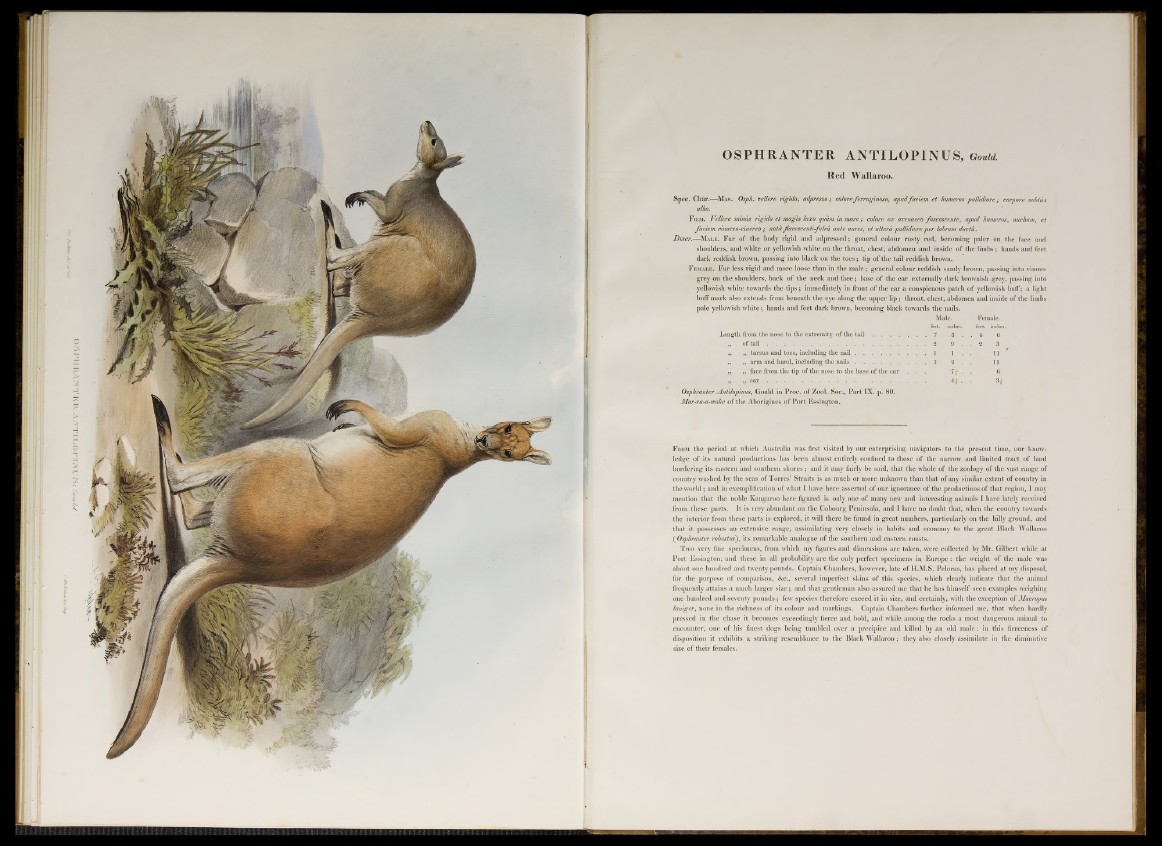
©SlPMlRANTKR AiYTiilLOrlMHJS: Gould:
OSPHRANTER ANTILOPINUS, Gould.
Red Wallaroo.
Spec. Char.— M a s . Osph. vellere rigido, adpresso; colore ferruginoso, apudfaciem et humeros pallidiore; corpore subtus
albo.
F<em. Vellere minus rigido et magis laxo quam in mare; colore ex arenaceo fuscescente, apud humeros, nucham, et
faciem vinaceo-cinereo ; nota flavescenti-fulm ante aures, et altera pallidiore per labrum duct a.
Descr.—M a l e . Fur o f the body rigid and adpressed; general colour rusty red, becoming paler on the face and
shoulders, and white or yellowish white on the throat, chest, abdomen and inside of the limbs; hands and feet
dark reddish brown, passing into black on the to es; tip o f the tail reddish brown.
F e m a l e . Fur less rigid and more loose than in the male; general colour reddish sandy brown, passing into vinous
grey on the shoulders, back o f the neck and face; base o f the ear externally dark brownish grey, passing into
yellowish white towards the tips; immediately in front of the ear a conspicuous patch o f yellowish buff; a light
buff mark also extends from beneath the eye along the upper lip ; throat, chest, abdomen and inside of the limbs
pale yellowish white; hands and feet dark brown, becoming black towards the nails.
Male. Female.
feet, inches. feet, inches.
Length from the nose to the extremity of the t a i l ...................... . . 7 3 . . 5 6
I of t a i l ...................................................................................... . . 2 9 . . 2 3
„ „ tarsus and toes, including the n a il................................ . . 1 1 . 11 *
„ „ arm and hand, including the n a i l s ................................ . . 1 2 . 11
„ „ face from the tip of the nose to the base of the ear 7± . 6
„ „ ear . . . . ................................................................. 44- . 34-
Osphranter Antilopinus, Gould in Proc. o f Zool. Soc., Part IX. p. 80.
Mar-ra-a-woke of the Aborigines of Port Essington.
F rom the period at which Australia was first visited by our enterprising navigators to the present time, our knowledge
o f its natural productions has been almost entirely confined to those o f the narrow and limited tract o f land
bordering its eastern and southern shores; and it may fairly be said, that the whole o f the zoology o f the vast range of
country washed by the seas o f Torres’ Straits is as much or more unknown than that o f any similar extent of country in
the world; and in exemplification of what I have here asserted o f our ignorance o f the productions of that region, I may
mention that the noble Kangaroo here figured is only one of many new and interesting animals I have lately received
from these parts. It is very abundant on the Cobourg Peninsula, and I have no doubt that, when the country towards
the interior from these parts is explored, it will there be found in great numbers, particularly on the hilly ground, and
that it possesses an extensive range, assimilating very closely in habits and economy to the great Black Wallaroo
( Osphranter robustus), its remarkable analogue o f the southern and eastern coasts.
Two very fine specimens, from which my figures and dimensions are taken, were collected by Mr. Gilbert while at
Port Essington, and these in all probability are the only perfect specimens in Europe: the weight of the male was
about one hundred and twenty pounds. Captain Chambers, however, late o f H.M.S. Pelorus, has placed at my disposal,
for the purpose o f comparison, &c., several imperfect skins o f this species, which clearly indicate that the animal
frequently attains a much larger s iz e ; and that gentleman also assured me that he has himself seen examples weighing
one hundred and seventy pounds; few species therefore exceed it in size, and certainly, with the exception of Macropus
laniger, none in the richness o f its colour and markings. Captain Chambers further informed me, that when hardly
pressed in the chase it becomes exceedingly fierce and bold, and while among the rocks a most dangerous animal to
encounter, one of his finest dogs being tumbled over a precipice and killed by an old male: in this fierceness of
disposition it exhibits a striking resemblance to the Black Wallaroo; they also closely assimilate in the diminutive
size of their females.